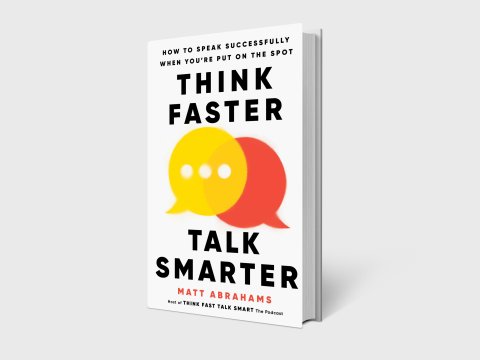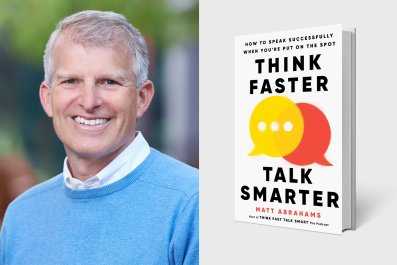Why are some people so good at small talk? Able to instantly engage with people they've just met, make their conversation partner feel at ease and like the most important person in the room? Able to seamlessly move from one conversation to another without awkwardness? It doesn't take a special gene to do those things. In fact, there are techniques and skills we can employ to help us be more confident in these situations. Stanford Business School lecturer and podcast host Matt Abrahams identifies best practices for spontaneous communication in his new book, Think Faster, Talk Smarter: How to Speak Successfully When You're Out on the Spot (Simon & Schuster). In this excerpt from his book, Abrahams shares tips and tricks for mastering small talk.

Networking and small-talk situations—the epitome of spontaneous speaking—make many of us cringe. Initiating and exiting these brief, informal encounters can feel incredibly awkward. During the encounters themselves, most of us feel as if we never quite know what to say and how to say it. We want to seem witty and interesting, but chatting breezily with others—whether at informal cocktail parties, corporate all-hands meetings, mixers at professional conferences, events at our kid's school or at many other gatherings—can seem like an endless verbal tennis match of spontaneous remarks, queries and feedback. It need not be this way. With some cognitive reframing, a useful structure and some specific guiding principles in hand, we can learn not just to survive small talk but to actually enjoy it.

Craft Your Content
My favorite formula to use when engaging in informal, spontaneous conversations is What–So What–Now What. First you make an argument or point (What), next you describe the significance of this information (So What) and then you suggest what your audience might do given their new knowledge (Now What). This structure helps with small talk precisely because it's general and versatile—you can use it in a wide variety of contexts and environments to help focus and clarify your remarks. Also, its final plank lends itself to asking questions of your small-talk partner, which, as we'll see, will help us to project empathy and interest in our partner. Now let's focus on how we might best apply it in chitchat.
Deploying What–So What–Now What can help us in two ways. First, if we seek to initiate or continue a conversation, we can simply ask these three questions to give the other person an invitation to speak. For example, we might say, "So, what did you think of the keynote speaker this morning?" (What) After the other person responds, we could follow up with another question: "How do you think the speaker's ideas will help in the short term?" (So What) The conversation after either of these questions might veer off into unexpected and interesting directions, and we might leave What–Now What–So What behind. But if we detect the energy in the conversation dissipating, we could come back with our third question: "Do you plan to go to the meet-and-greet the speaker is holding later?" (Now What)
What–So What–Now What can also help if others initiate a conversation with us and we wish to move the dialogue forward. Let's say we go to a convention for hikers and other outdoor enthusiasts and as part of the event there is a mixer. Someone comes up to us and asks what brought us there. We can respond, "Well, I have been an avid hiker for years [What]. I'm really excited to learn about the new equipment and tools they've got here, since I'm looking for ways to avoid getting injured and hiking farther [So What]. Do you do a lot of outdoor activities [Now What]?"
As helpful as What–Now What–So What might be to begin a conversation, it isn't always enough to allow us to shine during small talk. To become masters of chatter, we must pay more attention to our minute-to-minute roles as listeners and speakers. If you think about it, small talk is really just a conversation in which participants take turns speaking. We can break down this conversation further, noting the series of turn-takings that occur as participants wend their way through a series of topics. To perform well in spontaneous small-talk situations, we must strive to maximize each of our turns at speaking. And the best way to do that is to deploy what I call the First Commandment of Small Talk, which is...
Make It About Them, Not You
So often, we presume we must come across as witty and interesting to others—that we must command the room. As a result, we tend to overplay our hands, dominating the conversation and spending too much time talking about ourselves. Although most people might want to learn about us, they're probably even more interested in talking about themselves and feeling heard and understood by us. When we make the conversation about us, we deny them the opportunity to feel heard and understood. We come across as self-absorbed, unempathetic, arrogant and perhaps a bit clueless. Not the impression most of us want to leave.
At every turn we take, we have a chance to make the conversation about the other person as opposed to ourselves. Scholars distinguish between responses that support what another person is saying and those that shift the conversation back to you. If your friend complains about their annoying upstairs neighbor, you might say, "Yeah, you wouldn't believe what my neighbor's been putting me through. His party last night didn't break up until after three a.m." You've just shifted the conversation back to you and your concerns rather than inviting your small-talk partner to contribute even more. A support response might be to empathize with your friend and ask for more detail about their neighbor's bad behavior and how your friend handled it.

Avoid the 'How Are You?' Loop
A focus on making the conversation about them and not you also helps us with two special turns that occur in conversation: initiating and exiting. To initiate a small-talk conversation, avoid being generic or using a banal start such as "How are you?" or "What do you do?" Instead, approach the initiation of a conversation as an opportunity to show curiosity about the other person and their perspective. Questions about the situation or surroundings can work well, such as "Have you ever seen so many people in blue shirts before?" or "What do you think about the number of windows in this building?" The goal is to build rapport and connection from the start, and to do so by conveying interest in the other person or your shared experience in the moment. If you're entering a situation in which you anticipate engaging in small talk, you can think of a couple of ways to kick off a conversation while projecting warmth and curiosity prior to entering the event.
If you're the recipient of a common small-talk starting question, take care not to respond too quickly with a heuristic, since that could lead to what some have called the "How are you?" loop. (One person asks, "How are you?" and the other responds, "I'm good. How are you?" Not the most fascinating conversation.) Instead, try to answer in an interesting or intriguing way that invites further questioning. The key is to offer just a bit of detail about you and your interests. If someone asks how you are, try responding with something like "I am great because I hit a personal best during my workout this morning." Your partner might ask a follow-up question, and if they do, you can answer it and in fairly short order ask a question of them and then follow up with supportive responses.
Gracefully Leaving a Conversation
We can also make exiting conversations easier by trying to ensure that the other person feels appreciated. Many people try to end conversations by focusing exclusively on some need of their own. They might say, "I'm sorry, I need to refill my drink" or "Excuse, me, I have to use the bathroom." Professional matchmaker and communication consultant Rachel Greenwald points out, a better approach is to announce your departure and why you need to go but also exhibit curiosity by asking one final question that signals you've listened to what they've said and found conversing with them interesting. For example, "I'm going to check out the buffet in a minute, but I've loved chatting with you and just have one last question about that trip to Marrakesh you described. What was your favorite restaurant there, in case I get a chance to visit one day?"
Greenwald calls this the "white flag approach." In auto racing, the grand marshal waves a white flag to designate the final lap. We can do something similar when we engage in small talk by making a graceful exit which leaves our conversation partner feeling listened to and appreciated. My mother-in-law—a black-belt in small talk—would graciously and gracefully end her chitchat by saying something along the lines of "Thank you for telling me so much that I didn't know. I learned a lot from you. I have one more question for you before I need to go..."
Say you're at a professional function and have found yourself talking to someone about a recent move. You might say, "I'd like to know a bit more about why you chose to move to that part of town." Upon hearing your partner's response, you might end by saying, "Your choice makes a lot of sense. I need to reconnect with some colleagues over there. Thanks for giving me the scoop, and it was a pleasure to chat with you."
As we build up our spontaneous communication skills and with a bit of work, we can not only handle ourselves well but also begin to spread happiness, connection and collegiality wherever we go, inspiring others to open themselves up to people around them and to learn from them. The positive benefits of small talk can be significant indeed, but only if we break from our established habits and develop a more helpful—and structured—way of engaging. So don't struggle through another social occasion. Get out there and start practicing!

Copyright © 2023 by Matthew Abrahams LLC. From the forthcoming book Think Faster, Talk Smarter by Matt Abrahams to be published by Simon Element, an Imprint of Simon & Schuster, Inc. Printed by permission of Simon Element, an Imprint of Simon & Schuster, Inc. and MacMillan Business in the U.K.
Correction September 29, 2023, 3:20 p.m.: Copyright line was updated to include U.K. publisher.











